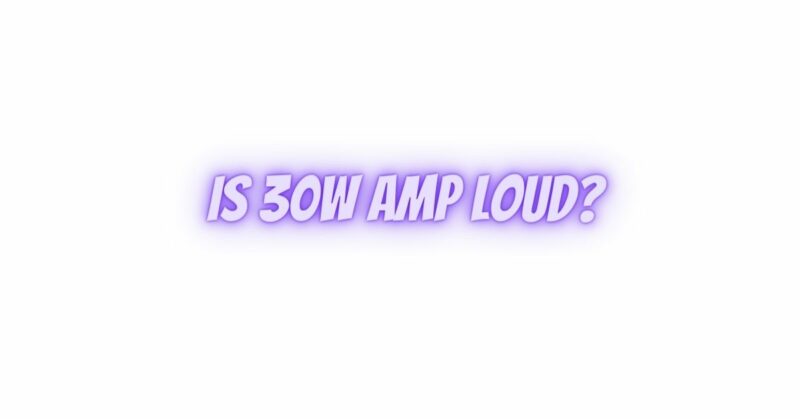When it comes to guitar amplifiers, the wattage rating can significantly impact the volume, tone, and overall performance. The question of whether a 30-watt amplifier is loud enough is a common one among musicians and guitarists. In this comprehensive guide, we’ll explore the factors that influence an amplifier’s loudness, discuss the advantages and limitations of a 30-watt amp, and provide insights to help you determine if it meets your volume needs.
Understanding Amplifier Wattage
Before diving into the loudness of a 30-watt amplifier, let’s clarify what amplifier wattage means and its relationship to volume:
- Amplifier Wattage (Watts): Amplifier wattage, often referred to simply as “watts,” measures the power output of the amplifier. It indicates how much electrical power the amplifier can deliver to the connected speaker(s).
- Volume and Clean Headroom: The wattage of an amplifier plays a crucial role in determining its volume capacity and clean headroom. Clean headroom is the point at which an amplifier produces a clean, undistorted sound before reaching its maximum output.
Factors That Influence an Amplifier’s Loudness
The loudness of an amplifier depends on several key factors beyond just its wattage:
- Speaker Efficiency: The efficiency of the amplifier’s speaker(s) affects how efficiently it converts electrical power into sound. More efficient speakers can produce more volume with the same amount of wattage.
- Speaker Size: The size of the speaker(s) impacts the overall sound projection and frequency response. Larger speakers can move more air and produce a fuller, louder sound.
- Amplifier Design: The design and circuitry of the amplifier influence its tonal characteristics, including how it handles volume. Some amplifiers are inherently louder than others with the same wattage rating.
- Tone Settings: The settings on the amplifier, such as EQ adjustments and gain, can affect the perceived loudness and tonal characteristics.
- Music Genre and Style: The type of music you play and your playing style may dictate the volume requirements. Certain genres, like metal, often demand higher volume levels for optimal performance.
Advantages of a 30-Watt Amp
A 30-watt amplifier offers several advantages that make it suitable for various playing scenarios:
- Volume Control: A 30-watt amp provides ample volume for most situations, making it suitable for rehearsals, small to medium-sized venues, and recording studios.
- Clean Headroom: A 30-watt amp typically has better clean headroom compared to lower-wattage amps. This means it can produce a clean and undistorted tone at higher volume levels before reaching its maximum output.
- Versatility: A 30-watt amp is versatile and can handle a wide range of music genres and playing styles. It offers enough power for clean tones while being capable of producing overdrive when pushed.
- Portability: Many 30-watt amplifiers are compact and lightweight, making them easy to transport for gigging musicians.
Limitations of a 30-Watt Amp
While a 30-watt amplifier is suitable for many situations, it may have limitations in specific contexts:
- Large Venues: In larger performance venues with significant stage space or when competing with a loud drummer, a 30-watt amp might not provide enough volume. In such cases, larger-wattage amplifiers or PA systems may be necessary.
- High-Gain Genres: For genres that demand extremely high-gain and heavy distortion at loud volumes (e.g., extreme metal), players may prefer higher-wattage amplifiers for maximum sustain and saturation.
- Clean Headroom Demands: Some musicians, especially jazz and country guitarists, may require exceptionally high clean headroom, which could lead them to consider higher-wattage amps.
Determining if a 30-Watt Amp Is Loud Enough
To determine if a 30-watt amp is loud enough for your needs, consider the following:
- Performance Context: Think about where you’ll be playing. A 30-watt amp is generally sufficient for small to medium-sized venues, rehearsals, and studio recording.
- Music Style: Consider the genre and style of music you play. If you require high levels of clean headroom or play in genres demanding extreme gain, assess whether a 30-watt amp can meet your tonal and volume requirements.
- Speaker Choice: The choice of speaker(s) can significantly affect the amp’s volume and tone. More efficient speakers or a larger speaker size can enhance the amp’s loudness and performance.
- Volume Management: Remember that a 30-watt amp can be quite loud, so be prepared to manage its volume settings for different playing situations.
- Audience Size: If you anticipate playing for larger audiences or in outdoor settings, consider whether your amp’s volume will be sufficient or if additional amplification (PA system) will be needed.
In conclusion, a 30-watt amplifier is generally loud enough for a wide range of musical scenarios, including rehearsals, small to medium-sized venues, and recording studios. However, the loudness of an amp depends on various factors beyond just its wattage rating, so it’s crucial to consider your specific playing needs, music genre, and venue size when determining if a 30-watt amp is the right choice for you.

